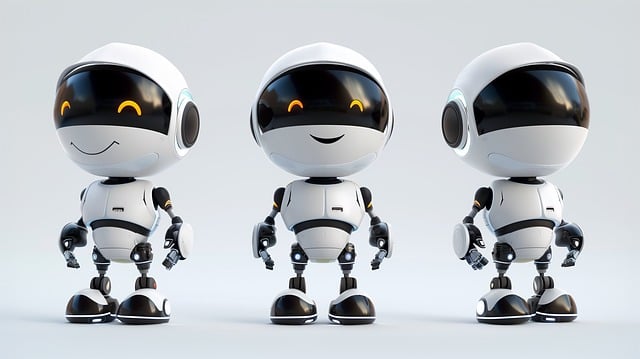Exploring the realm of artificial intelligence (AI) presents a fascinating journey into the future of communication. At the forefront of this transformation are AI chatbots, which have become increasingly sophisticated and integral to various industries. This article demystifies the process of building an effective AI chatbot by breaking down key components: understanding its capabilities and uses, defining objectives and user interactions, selecting the right technology stack, crafting a unique personality with advanced conversational skills, and ensuring successful testing, deployment, and maintenance in diverse real-world scenarios. Embark on this guide to unlock the potential of AI chatbots for your business or project.
- Understanding AI Chatbots: An Overview of Capabilities and Uses
- Designing Your Chatbot: Defining Objectives and User Interactions
- Choosing the Right Technology Stack for Your Chatbot Project
- Developing Your Chatbot's Personality and Conversational Abilities
- Testing, Deploying, and Maintaining Your AI Chatbot in Real-World Scenarios
Understanding AI Chatbots: An Overview of Capabilities and Uses

AI chatbots represent a significant advancement in artificial intelligence, designed to simulate human conversation through text or voice interactions. These sophisticated systems are powered by natural language processing and machine learning algorithms, enabling them to understand context, manage dialogue flow, and provide coherent responses that cater to user queries. The capabilities of AI chatbots extend beyond mere information retrieval; they can perform tasks such as scheduling appointments, setting reminders, answering FAQs, and even providing personalized recommendations based on user preferences.
The uses of AI chatbots are diverse and increasingly integrated into various sectors. In customer service, chatbots handle inquiries and issues efficiently, reducing response times and freeing up human agents for more complex tasks. They are also employed in e-commerce to guide customers through the purchasing process, offering product information and support. Healthcare has adopted chatbots to assist with patient engagement and monitoring, providing timely responses to medical queries and medication reminders. Furthermore, in the realm of entertainment, chatbots engage users in interactive narratives, pushing the boundaries of user experience. As AI technology continues to evolve, the potential applications for chatbots are bound to expand, making them an indispensable tool across many industries.
Designing Your Chatbot: Defining Objectives and User Interactions

When embarking on the journey to build an AI chatbot, a clear understanding of your objectives and how users will interact with it is paramount. Initially, you must define the purpose your chatbot serves within its intended ecosystem. Is it for customer service, e-commerce assistance, personal assistant functions, or perhaps for providing information? Your objectives will guide the design process, from choosing the right platform to deploying your chatbot to selecting the appropriate natural language processing (NLP) tools that allow for understanding and processing human language effectively.
Subsequently, user interactions must be carefully mapped out. This involves creating conversational flows and scripts that simulate various user scenarios. You should consider the types of queries users might have and the most effective ways to respond. The chatbot’s personality and tone can also influence how it communicates. Is a formal or casual approach more suitable for your audience? Testing different interaction models, from rule-based systems to machine learning conversational agents, will help you determine the most efficient and user-friendly design. Throughout this process, maintaining alignment with your defined objectives ensures that the chatbot remains focused on its primary function while providing a seamless and intuitive experience for users. By focusing on these aspects during the design phase, you lay a solid foundation for an AI chatbot that can effectively serve its purpose and enhance user engagement.
Choosing the Right Technology Stack for Your Chatbot Project

When embarking on the creation of an AI chatbot, selecting the appropriate technology stack is a pivotal decision that will influence the chatbot’s performance, scalability, and user experience. The choice of programming languages, frameworks, and tools should align with your project’s goals, whether it’s for customer service, lead generation, or providing information. For instance, Python has become a popular choice for developing AI chatbots due to its simplicity, readability, and the extensive ecosystem of data science and machine learning libraries available, such as TensorFlow and scikit-learn.
In addition to programming languages, consider leveraging natural language processing (NLP) services like OpenAI’s GPT or Google’s Dialogflow for advanced conversation handling capabilities. These platforms offer pre-trained models that can significantly reduce development time and cost. Moreover, selecting the right cloud platform—Amazon Web Services (AWS), Microsoft Azure, or Google Cloud Platform—can provide the necessary infrastructure to handle chatbot interactions at scale and maintain high availability. By carefully considering these elements and how they integrate with your project’s scope and objectives, you can lay a solid foundation for a successful AI chatbot deployment.
Developing Your Chatbot's Personality and Conversational Abilities

Crafting a chatbot that engages users effectively involves more than just programming responses; it requires developing a distinct personality and honing its conversational abilities. The AI chatbots of today can be imbued with a range of personalities, from friendly and helpful to witty or professional, depending on the intended use case. This personality shapes the user’s experience, making interactions more natural and enjoyable. To give your chatbot a unique character, consider its role within the company or service it represents, as well as the target audience. Personality traits can be programmed into the chatbot’s scripting and responses, ensuring consistency in tone and style.
Furthermore, enhancing conversational abilities in AI chatbots is about understanding context and nuance. Utilize natural language processing (NLP) technologies to enable the chatbot to comprehend user queries better and generate relevant, coherent responses. Continuously train your chatbot with diverse datasets to improve its ability to handle a wide array of conversations. This training should cover various topics and scenarios, allowing the chatbot to adapt to different contexts and maintain an engaging dialogue with users. Regular updates and machine learning algorithms can help your chatbot learn from interactions, refining its conversational skills over time and providing users with an increasingly seamless experience.
Testing, Deploying, and Maintaining Your AI Chatbot in Real-World Scenarios

When your AI chatbot’s framework is complete and its conversational abilities have been honed, rigorous testing becomes paramount. This stage involves simulating real-world scenarios to ensure the chatbot can handle a wide array of user interactions with grace and efficiency. Automated testing tools can help validate responses and workflows, while manual testing allows for the observation of nuanced human behaviors and the identification of areas where the AI might falter or provide less than optimal answers. It’s crucial to test across different platforms and devices, as varied interfaces may introduce unique challenges that could affect performance.
Upon successful testing, deploying your chatbot requires careful planning. Choose a deployment strategy that aligns with your user base’s needs and the intended scale of operations. For instance, deploying on messaging platforms like Slack or WhatsApp can cater to specific audiences, while a web-based solution might offer broader accessibility. Cloud services are often preferred for their scalability, reliability, and the ability to handle sudden surges in user interaction without compromising performance. Post-deployment, continuous monitoring and maintenance are essential to ensure the chatbot adapts to evolving conversational trends and user feedback. Machine learning algorithms can be retrained with new data to refine responses and improve accuracy over time. Regular updates and patches may also be necessary to address any technical issues or to integrate new features requested by users. By committing to these ongoing efforts, your chatbot will not only remain effective but can also grow more sophisticated, enhancing user satisfaction and engagement in real-world applications.
In conclusion, building an AI chatbot is a multifaceted process that requires a clear understanding of your objectives, the capabilities of AI technology, and the intricacies involved in crafting meaningful user interactions. By carefully selecting the appropriate technology stack, you can develop a chatbot with a distinct personality and advanced conversational abilities tailored to your specific needs. The key to success lies in thorough testing within real-world scenarios to ensure your chatbot operates effectively and continues to learn from its experiences. As AI chatbots become increasingly sophisticated, they offer immense potential for businesses and service providers alike, transforming the way we interact with digital platforms. Embracing this technology can lead to more efficient customer service, streamlined operations, and innovative user engagement strategies. With the right approach, your AI chatbot can become an invaluable asset in the digital age.
